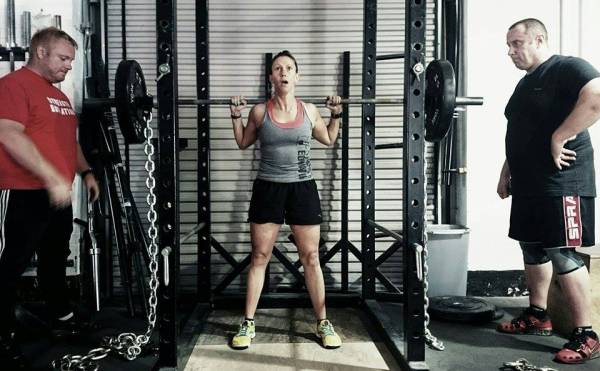What’s the purpose of weight lifting? There are a number of ways to approach this question, but for a moment let’s focus on the most basic answer. When you lift weights, what exactly are you trying to do?
Simple, really. You’re trying to pick something up and move it. Looked at this way, the primary goals of lifting become more obvious: force production and, sometimes more importantly, force transfer. After all, what good is the ability for individual muscles to produce force if none of that force is reaching the bar? But how do you achieve these goals?
Force Production Versus Force Transfer
Improving force production isn’t complicated. You use good technique to lift a bit more weight than you did yesterday. Lather, rinse, repeat. Improving force transfer, while not significantly more complex, can seem strange and almost esoteric at first. I know it did to me. Through several years of investigation and experimentation, I’ve come to a more simplified understanding.
- The things you do to contribute to force production occur during the lift.
- The things that you do to optimize force transfer happen before the lift.
Simplifying even further: optimal force transfer is all about your set up. Imagine you’re in your gym with concrete floors covered in industrial rubber mats. Jumping on this surface is easy because as you press down on the floor little force is lost and you propel yourself into the air. Now imagine trying the same thing on a canoe in a lake. Rather than propelling yourself into the air, you’re much more likely to propel the canoe out from under you and plunge face first into the water.
“When you breathe better, you brace better, and when you brace better, you can express your strength far more effectively.”
If you insert a barbell into the metaphor, it changes a bit. Now you’re the object providing stability for the barbell’s movement. Which would you rather be, a concrete foundation or a wobbly canoe on a river? If your goal is to move as much weight as possible, the answer is obvious.
Here are three easy corrections new lifters can make to turn their canoe into concrete and see immediate improvements.
Diaphragmatic Breathing
For a lot of beginners, the idea of bracing seems foreign. “What do you mean I can’t just go pick the weight up and move it?” Ten years ago, I was one of those people. It took getting hurt a few times for me to realize how important proper bracing is.
It turns out a lot of the muscles in your midsection are optimally activated in the presence of proper breathing patterns. When you breathe better, you brace better, and when you brace better, you can express your strength far more effectively.

When I first started powerlifting, I was taught to brace by pushing my belly into my belt. While this worked to a degree, it’s definitely sub-optimal. Try this instead.
90-90 Breathing:
- Lay on the floor with your feet on a wall. Your hips and knees should both be at a comfortable ninety degrees.
- Turn your palms face up and rest the back of your hands on the floor.
- Flatten your back against the ground. You don’t have to try to crush a bug under your back, just make light contact.
- Take a breath and draw down into your stomach, using the inhalation to push your lower back into the ground further.
- As you continue to inhale, imagine the air moving from your low back to your upper back. Make sure your ribcage is not rising excessively to accomplish this.
- Once you’ve inhaled as much as you can, exhale forcefully.
- Repeat for 15-20 breaths.
If you’re having trouble with this, you can also set a timer and focus on breathing until the alarm goes off. The sets and reps aren’t as important as feeling like you’ve regained maximal lung expansion.
How do you know when this happens? You can test with a weight belt. Put it on and brace up. If you’ve been successful in your breathing, you should feel yourself creating pressure in all directions, as well as the resultant increase in stability.
“The sets and reps aren’t as important as feeling like you’ve regained maximal lung expansion.”
Trust me, you’ll feel it. Learning how to breathe properly can have a huge impact on your performance. Proper bracing is just one of the many benefits. Try including this drill as part of your warm up before your next lift, especially if you’re going heavy.
Flex Your Glutes
Force production starts at the ground and ends in whichever direction you’re trying to move the weight. Whether you’re squatting, pulling, or even doing a bench press, solid contact with the ground is important for maximal force production.

In most lifts, the movement starts by pushing into the ground with our feet and holding the weight in our hands. This means we need to maintain tension in every muscle in between in order to move the most weight. An area where a lot of people are bleeding force is through their glutes.
While I’m a firm believer that flexing your glutes can pretty much make you better at everything, in this particular example, it helps lock your body in place and provide the rigid, stable foundation you need to express your strength. Next time you’re fighting to lock out a lift overhead, try flexing your glutes. Ideally, you should have tightened them prior to the lift as part of your setup, but you might be surprised how much of a difference the increased stability makes even mid-lift.
“[W]e need to maintain tension in every muscle in between in order to move the most weight. An area where a lot of people are bleeding force is through their glutes.”
Learning to flex your glutes doesn’t require any fancy drills. Simply try squeezing your glutes like you’re trying to pinch a pencil between them. Hold for 3-5 seconds. Do this a few times a day and try to do it from different positions (standing, seated, etc.). Not only will you keep your glutes ready to work, but your knees and lower back will thank you – hopefully with new personal records.
Squeeze the Bar
In the simplest sense, grip strength is one of the most important variables in your ability to move weights. If your physical attachment to the bar isn’t strong, it’s unlikely you’ll be able to move the bar with any kind of strength.

One of the most common mistakes newer lifters and athletes make is to grab the bar with just enough force to hold onto it. Movement starts in the mind and different intentions achieve different results. When you first grab the bar, squeeze it like you’re trying to crush it in your hands.
There seem to be significant neurological implications revolving around grip strength. It’s used as a common tool for strength assessment following a stroke, although it’s efficacy is debated. And there are several people in the fitness community who believe grip strength can be like a neurological brake: if you can’t hold onto the weight, your body won’t let you exert maximal force with other muscles. One of these people is Pavel Tsatsouline. I think it’s safe to say he knows some things.
Summary
Setting up for each lift is unique, but these three factors apply to all of them. While programming and mechanics are important, you need to first be able to express your strength in order to improve it.
Check out these related articles:
- 3 Reasons You Don’t Squat More (And What to Do About It)
- How to Get Your Grip Stronger
- Breathing and Abdominal Bracing For Strength
- What’s New On Pulse Beat Fit Today
Photos 1 & 3 courtesy of CrossFit Empirical.
Photo 2 courtesy of Strength Education.
Photo 4 courtesy of Shutterstock.






